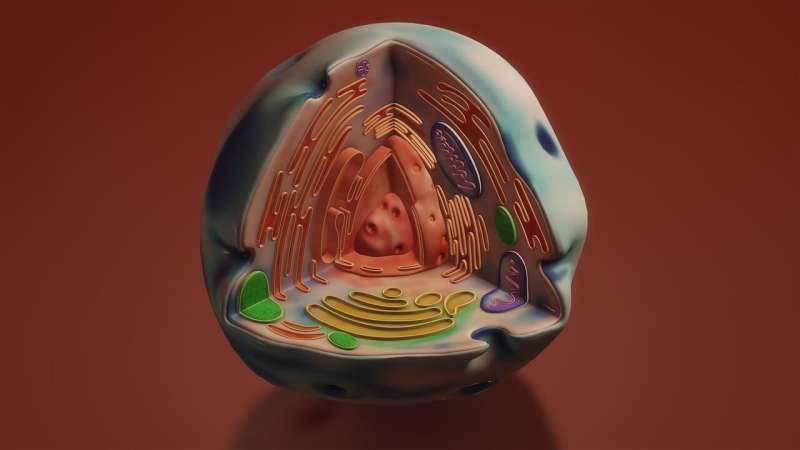This article has been reviewed according to Science X's editorial process and policies. Editors have highlighted the following attributes while ensuring the content's credibility:
fact-checked
peer-reviewed publication
trusted source
proofread
The Golgi organelle's ribbon structure is not exclusive to vertebrates, contrary to previous consensus

Researchers report February 29 in the journal Cell Reports that the Golgi ribbon, an organelle structure previously thought to be exclusive to vertebrates, is also present in animal taxa, including mollusks, earthworms, and sea urchins.
The function of the Golgi ribbon is still enigmatic, but its presence in diverse animal lineages indicates that its function is not vertebrate-specific, as previously thought. The team also showed Golgi ribbons form at a specific timepoint during embryogenesis, which suggests that they might play a role in cell differentiation.
"The Golgi ribbon is a very ancient innovation, and it's much more widespread than previously thought," says senior author and cell biologist Francesco Ferraro of the Stazione Zoologica Anton Dohrn. "It's still not clear why you need this structure, but the fact that it has been conserved for over 600 million years and is still so widespread suggests that its functions are really fundamental."
Golgi complexes are found universally in eukaryotes, but their overall organization varies. The organelles consist of stacks of membranous sacs that process and package proteins so that they can be transported to other parts of the cell or excreted from the cell.
Single-celled eukaryotes tend to have single Golgi stacks, while plants, fungi, and some animals have multiple stacks scattered throughout the cytoplasm, and other animals have multiple Golgi stacks that are connected to form a ribbon-like structure.
The current consensus among cell biologists is that Golgi ribbons are exclusive to vertebrates, but when Ferraro's team observed ribbon-like Golgi in the embryos of sea urchins, they set out to investigate how common Golgi ribbons are among non-vertebrates. To do this, the researchers surveyed Golgi structure in representatives of various animal taxa and closely related unicellular eukaryotes.
They found that Golgi ribbons are present in both vertebrates and invertebrates, including mollusks, annelids (e.g., earthworms), and echinoderms (e.g., starfish and sea urchins). However, Golgi ribbons are not present in arthropods or nematodes or in more primordial animal taxa, such as sponges and comb jellies.
Based on its scattered but widespread occurrence, the researchers think that Golgi ribbons evolved only once—around 600 million years ago in the ancestor of all cnidarians and bilaterians, which includes all animals aside from sponges, comb jellies, and placozoans—but was subsequently lost in some bilaterian lineages, including nematodes and arthropods.
"Golgi ribbons predate the evolution and diversification of the vertebrae lineage, which means that it did not evolve to do something specific for the cellular physiology of vertebrates," says Ferraro.
Next, the team wanted to explore the mechanism behind Golgi ribbon formation and evolution. In mammalian cells, Golgi ribbons are formed when multiple Golgi stacks are linked together via molecular tethers that include "GRASP" proteins, which connect adjacent Golgi stacks, and "golgin" proteins, which serve as anchor points for the GRASP proteins.
The researchers knew from previous studies that ribbon formation requires GRASPs to bind to either of two golgins, and using AlphaFold2 modeling, they deduced that these anchor points likely evolved at different times: their analysis predicted that one anchor point evolved in the common ancestor of all multicellular animals, while binding by the other golgin appears to have evolved in the common ancestor of cnidarians (i.e., sea anemones, coral, and jellyfish) and bilaterians.
The function of Golgi ribbons remains enigmatic, but the researchers suspect that it is involved in cellular differentiation during embryogenesis. By analyzing Golgi dynamics in developing sea urchins (Paracentrotus lividus), sea squirts, and lancelets, they showed that Golgi stacks remain separate during the first few rounds of cell division, but they connect to form a centralized Golgi ribbon at a specific point during embryogenesis.
"The formation of these centralized Golgi ribbons occurs just before gastrulation, which is the developmental stage at which the embryos establish the fate of different tissues and the body plan of the animal," says Ferraro.
"Based on this conserved timing of formation, we propose that the Golgi ribbon might have a function in embryo development and differentiation, which is something that nobody has thought about before."
Now, the researchers are "testing the idea that the ribbon actually has something to do with the differentiation," says Ferraro. Understanding the function of Golgi ribbons could have important medical implications, since Golgi ribbons are known to disassemble and contribute to pathology in neurodegenerative diseases, cancer, and some viral infections.
"Ribbon disassembly is involved in a lot of human pathologies, and so maybe if we understand what its functionality is, we can have better insight into the causes of these diseases," says Ferraro.
More information: Evolution of the ribbon-like organization of the Golgi apparatus in animal cells, Cell Reports (2024). DOI: 10.1016/j.celrep.2024.113791. www.cell.com/cell-reports/full … 2211-1247(24)00119-0
Journal information: Cell Reports
Provided by Cell Press




















